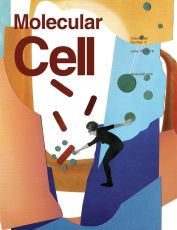News Archive
Unveiling the ubiquitin fingerprint induced by Salmonella infection.
September 2016. Salmonella Typhimurium is Gram-negative bacterium that represents one of the major causes of food-borne diseases in the world and provokes one third of all infections with fatal outcome. This bacterium has evolved several strategies to survive in the human body and to prevent its killing by host immune cells. Its major advantage is its intracellular lifestyle: The bacterium gets enclosed in Salmonella-containing vacuoles upon entry into the cell, allowing its replication and propagation. However, also the host cells have developed defence mechanisms against bacterial infection and mark bacterial intruders with ubiquitin resulting in their degradation via the autophagy system (a process called xenophagy). Hence, a cellular invasion by bacterial pathogens can immediately be detected on the molecular level.
For gaining deeper and more global insights into the mechanisms upon bacterial infection, the groups of Christian Behrends and Ivan Dikic from the Institute of Biochemistry II in Frankfurt have studied the dynamic changes within a host cell in response to an infection with Salmonella. The results of the analysis, published in the journal Molecular Cell on 16 June 2016, reveal the impact of the bacterial invasion on several critical pathways of the host cell.  Like criminal profilers, and using quantitative mass spectrometry, the scientists tracked all ubiquitination events within the host cells upon their infection with Salmonella. Knowing that cells commonly use ubiquitination to relay signals, the scientists hypothesized that all proteins becoming ubiquitinated after Salmonella invasion must be involved in either propagating or limiting the infection. Indeed, this novel approach gave an unprecedented insight into all cellular processes affected by the infection and identified important new regulatory hubs. Specifically, the most significant alterations of the host ubiquitinome concerned components of the actin cytoskeleton, the NF-κB and the autophagy pathway as well as the ubiquitin and the RHO GTPase systems.
Like criminal profilers, and using quantitative mass spectrometry, the scientists tracked all ubiquitination events within the host cells upon their infection with Salmonella. Knowing that cells commonly use ubiquitination to relay signals, the scientists hypothesized that all proteins becoming ubiquitinated after Salmonella invasion must be involved in either propagating or limiting the infection. Indeed, this novel approach gave an unprecedented insight into all cellular processes affected by the infection and identified important new regulatory hubs. Specifically, the most significant alterations of the host ubiquitinome concerned components of the actin cytoskeleton, the NF-κB and the autophagy pathway as well as the ubiquitin and the RHO GTPase systems.
Given the increased occurrence of antibiotic resistance in bacterial pathogens, which hampers current treatment schemes and prompts the need for alternative anti-bacterial strategies, this comprehensive dataset will reveal new targets for inhibiting Salmonella propagation and preventing the associated inflammatory reaction.
Contacts:
Christian Behrends (behrends@em.uni-frankfurt.de)
Ivan Dikic (dikic@biochem2.uni-frankfurt.de)
Institute of Biochemistry II
Goethe University Frankfurt
Germany
Full Reference:
Fiskin E, Bionda T, Dikic I, Behrends C (2016). Global Analysis of Host and Bacterial Ubiquitinome in Response to Salmonella Typhimurium Infection. Mol Cell. 62:967-81. doi: 10.1016/j.molcel.2016.04.015. Link to full article
Link to F1000 Article Recommendation
Link to Meet the authors
Link to Autophagic Punctum

